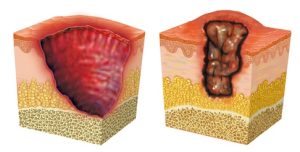How Quickly Can Bedsores Develop on a Nursing Home Patient?

Decubitus ulcers, commonly referred to as bedsores or pressure ulcers, develop in individuals who are chair-bound or bed-bound for an extended period. Many ulcers begin forming in as little as a week when lying or sitting in the same place. On average, bed sore developing skin ulcers become serious in less than a month of being bound to a chair or bed.
Bedsores on the skin are caused by continuous pressure and irritation at any specific location on the body. However, bedsores tend to be common on prominent bony areas including the buttocks, hips, elbows, back of the head, shoulders, lower back, and heels. Bed sores can be minimized when taking preventative measures including changing body position whenever possible to relieve pressure.
Most Common Bed Sore Occurrences
Bedsore-developing ulcers are often a common occurrence in hospital patients. Research indicates that as many as five percent of individuals admitted to a hospital, nursing home, or healthcare facility can develop a pressure ulcer within a week or two. The most common bedsore occurrences happened for a variety of reasons including:
- The patient is not very mobile and unable to change body position
- The patient is seriously ill, such as patients in ICU (intensive care unit)
- Individuals suffering a spinal cord injury and are unable to feel or move the legs and/or arms
- Individuals with a poor diet
- Individuals wearing a plaster cast for a broken limb, a body brace, or a prosthesis (artificial limb)
- Smokers
- Individuals suffering from diabetes who lose the ability to sense pain or major discomfort
- Individuals suffering incontinence of feces or urine where the skin remains damp, increasing the potential of damage
- Individuals suffering from heart failure or COPD (chronic obstructive pulmonary disease)
- Those with rheumatoid arthritis, Parkinson’s disease, or Alzheimer’s disease
- Individuals who have recently undergone hip surgery or nursing a broken hip
- People with poor circulation in the arms and legs (peripheral vascular disease) where the arteries are narrowed by atheroma
Identifying a Bed Sore
Decubitus ulcers often appear in various stages depending on severity. Medical care identifying or grade the sore, based on the depth of the ulcer.
- Grade #1 – The patient’s skin appears permanently red but has no crack or break in the surface. Often times, the area feels warm and hard to the touch, and slightly swollen. Individuals with dark skin often have bedsores that are blue or purple in color.
- Grade #2 – The bedsore appears superficial much like an abrasion or blister.
- Grade #3 – The decubitus ulcer penetrates throughout the entire thickness of the patient’s skin where obvious damage appears in underlying tissue.
- Grade #4 – This type of ulcer is the most severe, where the sore is deep with significant damage to the bone and muscle beneath.
Preventing Bed Sores
The National Institutes of Health (NIH) recommends consulting a healthcare provider as soon as possible whenever a noticeable bedsore appears. This is because surgery is usually required to repair and heal this kind of wound. The healing process of a decubitus ulcer often involves:
- The ulcer is becoming smaller in size
- The sore starts to develop pink tissue along its edges while increasing in size toward the center
- During the healing process, noticeable healing signs include bumpy or smooth surfaces of new tissue growth
- Bleeding can be present at the site indicating good blood flow circulation to the damaged area to promote and escalate healing
However, many bedsores do not heal without medical treatment. Often times, noticeable signs of necessary medical care can appear. These signs can include:
- Significant drainage at the ulcer site or an increase in its size
- Increase redness at the site or black areas beginning to form
- A noticeable odor and/or extensive drainage with a green color at the sore site
- Any indicator of a fever
Healthcare Provider Neglect
Anytime a bedsore is neglected in a hospital, nursing facility or assisted living home, it can be life-threatening. Many victims of abuse or neglect can develop an infection that can easily spread to the bone, heart and blood. Serious neglect of the decubitus ulcer can lead to amputation or autonomic dysreflexia (overactive autonomic nervous system).
Placing a loved one in a nursing home for necessary care requires a level of trust. Unfortunately, whenever the trust is violated, the loved one can suffer a variety of serious injuries including debilitating bedsores. When this happens, it is important that family members hold the nursing home accountable for their negligence and abuse.
The legal team at Nursing Home Law Center LLC at (800) 926-7565 is experienced in nursing home negligence cases involving serious injuries. We offer free consultations to evaluate the circumstances surrounding all treatments or lack of treatment to assist in obtaining financial compensation for your loved one.
- http://www.nlm.nih.gov/medlineplus/pressuresores.html#cat3
- http://www.nlm.nih.gov/medlineplus/ency/patientinstructions/000147.htm


